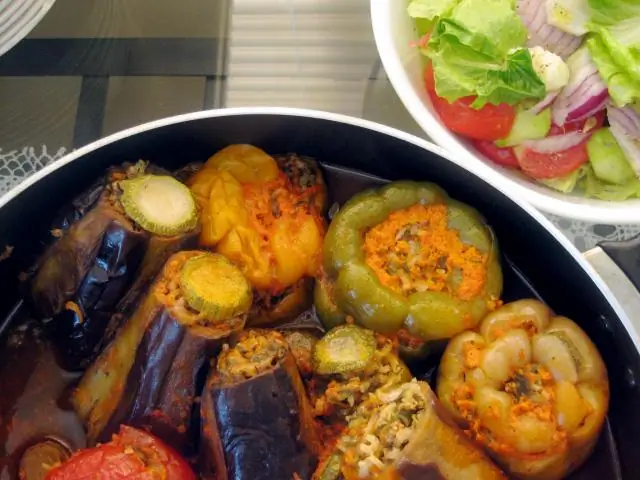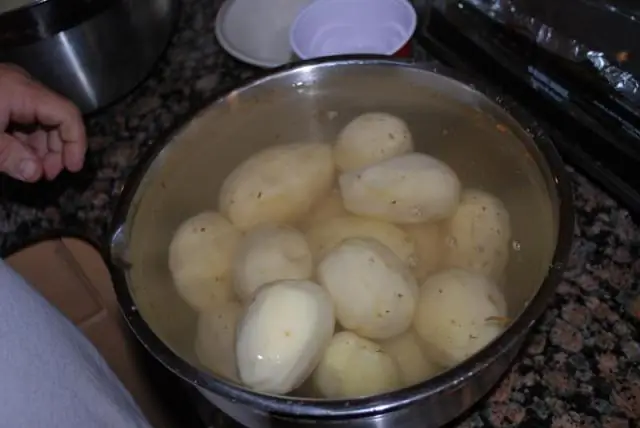
Table of contents:
- Author Bailey Albertson [email protected].
- Public 2023-12-17 12:53.
- Last modified 2025-01-23 12:41.
How to properly peel eggplants for stews and other dishes

Eggplant has long become a common vegetable for us, although not quite traditional for Russian cuisine. Many housewives have their favorite eggplant recipes: caviar, stews, salads, fried, stewed or baked. But the question often arises: is it necessary to peel the eggplants before cooking, and if so, how to do it correctly?
Why peel eggplant?
As you know, this vegetable is not only tasty, but also extremely beneficial for health, due to the content of substances that improve the functioning of the cardiovascular system: zinc, manganese and iron.
Scientists claim that in many fruits, most of the nutrients are concentrated in the skin and the thin layer of pulp under it. Does this mean that the eggplant should be eaten unpeeled? It is embarrassing that the skin can be hard and bitter, which will negatively affect the taste. We suggest you solve this issue yourself, using our advice.

Eggplant Skin Contains Health Benefits
- The skin contains dietary fiber, which is often necessary for our body for the good functioning of the gastrointestinal tract. From a dietary point of view, the peel is healthy and nutritious.
- Overripe, old eggplants must be peeled. Their skin is thick and rough, it has most likely lost its useful properties, and it is difficult to cook it to the desired softness. Young eggplants do not need to be peeled.
- Most of the bitterness is not concentrated in the peel, but in the pulp. Therefore, experienced housewives soak sliced eggplants in salt water, which is then drained.
- Whether or not you need to peel the eggplant also depends on the dish you want to cook. For example, if you need to fry or grill slices, the skin will keep the eggplant's shape and prevent it from falling apart. Finely diced stews or breaded roasts will not fall apart without the skin.
And finally. If you grow eggplants in your own garden, and do not use pesticides, nitrates and substances that accelerate the growth of fruits, then peeling is not necessary. But store-bought eggplant, or bought on the market, is better to peel: how do you know in what conditions they were grown?
We clean correctly
If you do decide to peel your eggplant, you will need:
- an ordinary kitchen knife;
- a special knife for peeling vegetables or a vegetable peeler;
- paper kitchen towels.
So let's get started:
Rinse the eggplant thoroughly, removing all dirt from it. The surface can contain harmful bacteria, which will get onto the pulp during the cleaning process. Dry the vegetables with a paper towel after washing

Rinse the eggplant thoroughly
- Use a sharp kitchen knife to cut the tip of the eggplant just below the base of the stem. This part is usually hard and tough, it is undesirable to use it in cooking.
- The stem of the eggplant has been removed, making it much easier to peel off the skin. You can also trim off the bottom tip by about a centimeter.

Cut off the top and bottom ends of the eggplant
- Next, remove the skin in strips for this, put the eggplant "on the bottom", take a vegetable peeler, press the blade to the top and smoothly slide down along the entire length.
- During the process, do not point the peeler or tilt the vegetable towards you. Tilt the eggplant slightly away from you or to the side.
- If you don't have a peeler, use a small knife. Also carefully slide the knife from top to bottom, trying to cut off only a thin layer of the skin without touching the pulp.

Peel off the skin gently with a peeler or knife
This way, peel the whole eggplant without leaving any skin marks on it.
This cleaning method is perfect for further use of eggplants in stews, for frying, stewing, making salads and canning
Striped eggplants
This simple option will not only keep the pulp from falling apart during the cooking process, but will also help you get funky pieces that can be grilled, stewed, or pickled for the winter.

Eggplant, peeled in strips
It is enough to use the previous method, but do not peel off the skin completely, but leave strips 2-2.5 cm wide. Thus, you will get uniform dark-light areas. After peeling, cut the eggplant into strips or long, longitudinal pieces. During cooking, the pulp will retain not only its shape, but also its color and aroma.

'Striped' eggplant, cut into wedges
Cleaning after cooking
Most often, eggplants are cleaned fresh before proceeding with the recipe. But you can do otherwise. Bake the eggplant in the oven or boil in boiling water, after which the skin will easily separate.
Wait for the eggplant to cool slightly. Take a small kitchen knife and, while holding the vegetable with one hand, gently peel the skin off with the other without touching the flesh.

Cleaning the eggplant after cooking
If the eggplant is soft enough, the skin can be easily removed with your fingers. You can even use a spoon or fork to do this if you only cooked the eggplant for yourself and you don't need to worry about setting the table.
This method is great for stuffed baked eggplants. Also, such a vegetable can be cut for a salad or stew, which will cook much faster, because the eggplant has already passed the initial heat treatment.
Eggplant peeling video
Now you know how to properly peel eggplant for various dishes. We hope our tips have helped you. Share with us and our readers your thoughts on this topic in the comments. Bon appetit and comfort to your home!
Recommended:
How To Check Cottage Cheese For Quality And Naturalness At Home With Iodine And Not Only + Photos And Videos

Where to stop the choice - on cottage cheese or curd product? Description of simple ways to check the quality and naturalness of a product at home. Video
How To Peel Pine Nuts At Home - Different Ways To Peel These Nuts From The Shell + Photos And Videos

Removing the shell from nuts is a serious task. How to clean pine nuts at home with a minimum of effort
How To Make Soap At Home With Your Own Hands: Making Solid, Liquid, From A Soap Base And Not Only, Master Classes With Photos

Making soap at home with your own hands. What can be done, what components are required, step-by-step master classes with photos
How To Peel Pomegranates: Ways To Do It Quickly And Correctly, Photos And Videos

Step-by-step instructions for easy cleaning of a pomegranate. Detailed descriptions of different methods
Salad Recipes Herring Under A Fur Coat: How To Cook A Classic And Not Only, How To Lay Out The Layers In Order, Step By Step With Photos And Videos

The classic recipe for New Year's salad Herring under a fur coat and its modern variations with additional ingredients
